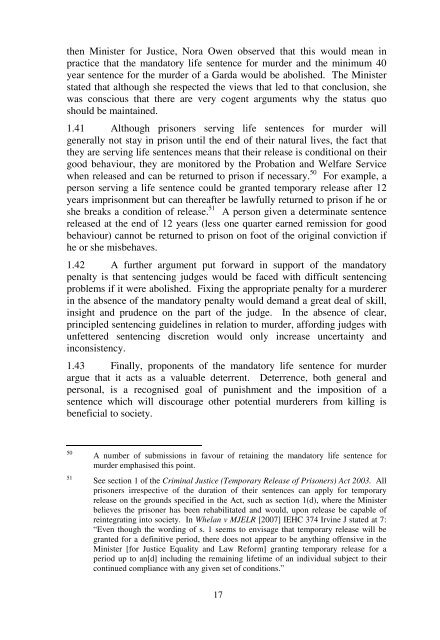murder and involuntary manslaughter - Law Reform Commission
murder and involuntary manslaughter - Law Reform Commission
murder and involuntary manslaughter - Law Reform Commission
Create successful ePaper yourself
Turn your PDF publications into a flip-book with our unique Google optimized e-Paper software.
then Minister for Justice, Nora Owen observed that this would mean inpractice that the m<strong>and</strong>atory life sentence for <strong>murder</strong> <strong>and</strong> the minimum 40year sentence for the <strong>murder</strong> of a Garda would be abolished. The Ministerstated that although she respected the views that led to that conclusion, shewas conscious that there are very cogent arguments why the status quoshould be maintained.1.41 Although prisoners serving life sentences for <strong>murder</strong> willgenerally not stay in prison until the end of their natural lives, the fact thatthey are serving life sentences means that their release is conditional on theirgood behaviour, they are monitored by the Probation <strong>and</strong> Welfare Servicewhen released <strong>and</strong> can be returned to prison if necessary. 50 For example, aperson serving a life sentence could be granted temporary release after 12years imprisonment but can thereafter be lawfully returned to prison if he orshe breaks a condition of release. 51 A person given a determinate sentencereleased at the end of 12 years (less one quarter earned remission for goodbehaviour) cannot be returned to prison on foot of the original conviction ifhe or she misbehaves.1.42 A further argument put forward in support of the m<strong>and</strong>atorypenalty is that sentencing judges would be faced with difficult sentencingproblems if it were abolished. Fixing the appropriate penalty for a <strong>murder</strong>erin the absence of the m<strong>and</strong>atory penalty would dem<strong>and</strong> a great deal of skill,insight <strong>and</strong> prudence on the part of the judge. In the absence of clear,principled sentencing guidelines in relation to <strong>murder</strong>, affording judges withunfettered sentencing discretion would only increase uncertainty <strong>and</strong>inconsistency.1.43 Finally, proponents of the m<strong>and</strong>atory life sentence for <strong>murder</strong>argue that it acts as a valuable deterrent. Deterrence, both general <strong>and</strong>personal, is a recognised goal of punishment <strong>and</strong> the imposition of asentence which will discourage other potential <strong>murder</strong>ers from killing isbeneficial to society.5051A number of submissions in favour of retaining the m<strong>and</strong>atory life sentence for<strong>murder</strong> emphasised this point.See section 1 of the Criminal Justice (Temporary Release of Prisoners) Act 2003. Allprisoners irrespective of the duration of their sentences can apply for temporaryrelease on the grounds specified in the Act, such as section 1(d), where the Ministerbelieves the prisoner has been rehabilitated <strong>and</strong> would, upon release be capable ofreintegrating into society. In Whelan v MJELR [2007] IEHC 374 Irvine J stated at 7:“Even though the wording of s. 1 seems to envisage that temporary release will begranted for a definitive period, there does not appear to be anything offensive in theMinister [for Justice Equality <strong>and</strong> <strong>Law</strong> <strong>Reform</strong>] granting temporary release for aperiod up to an[d] including the remaining lifetime of an individual subject to theircontinued compliance with any given set of conditions.”17
















